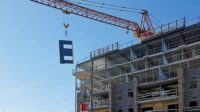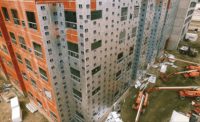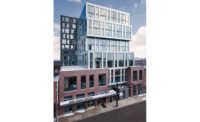In a polar vortex, an extended hard freeze, steady rainfall, extreme heat, or a global pandemic, construction often slows down or can come to a complete halt. With the rise of panelization, the rules of engagement are changing rapidly. Construction crews can now more effectively manage weather sensitivity and manpower requirements, thereby keeping projects on schedule. That translates into time and money savings, which are game changers on any construction site.
Prefabrication teams can manufacture the exterior walls of a building from stud wall all the way through to the external cladding in a climate-controlled facility that is not exposed to the elements. Once the prefabricated wall panels are fully assembled, they are loaded, wrapped, and transported to the job site where they are hoisted into place using a crane.
With Mother Nature’s role in construction tremendously reduced, prefabrication can provide up to an 80-percent reduction in building envelope installation time, a substantial decrease in manpower needs, and assurance that temperature-sensitive materials are installed indoors.
Prefabrication is a methodology of construction and requires a different mindset from all involved parties, including owners, architects, general contractors, wall consultants, fabricators, installers, and other related trades. Today, panelization is best accomplished in a permanent manufacturing facility that provides certainty and proper protection in a constantly controlled environment.
A New Mindset
With prefabrication, fresh insights into project delivery have driven innovation. When owners, architects, general contractors and prefabricated panel manufacturers come together, the contributions that prefabricated exterior wall panels can make in solving complex challenges become clearer.
Panelization and prefabrication deliver multiple benefits and savings, including:
- Schedule Certainty: Prefabricated walls are manufactured and prepared for delivery once a project is ready for installation. There are no delays due to weather.
- Shortened Schedule: Installation is typically completed in weeks rather than months. Wall panels can be fabricated at the same time as the building structure is coming out of the ground, condensing the overall construction timeline.
- Climate-Controlled: Extreme temperatures, rain, snow, and humidity are no longer a factor and do not slow down the panel fabrication process.
- Higher Quality: Prefabricated panels are quality-controlled and adhere to manufacturers' quality control guidelines.
- Smaller Crews: Prefabricated wall systems can be installed with smaller crew sizes (typically six to eight people), which is a 60-percent or greater reduction in jobsite workforce compared to on-site construction.
- Lightweight Panels: Energy-efficient, lightweight panels reduce structural and foundation requirements.
- Reduced Carbon Footprint: A reduction in crew members commuting to a job site combined with a decrease in material waste creates a lower carbon footprint than traditional construction methods.
- Improved Safety: When scaffolding is removed and the number of on-site personnel is reduced, safety is improved.
- Diverse Aesthetic Options: Prefabrication allows for unlimited color, texture, and cladding material options, providing architects with the freedom to create striking, customized façades.
- Code Compliance: Prefabricated wall manufacturers typically provide evidence of building code compliance (such as International Code Council Evaluation Reports) with each panel design.
As the construction industry struggles with fewer professionals entering the field than those exiting, prefabrication provides a solution for the shrinking labor pool as well. Factory prefabrication offers tradespeople full-time careers with employers who are invested in their success. Better-trained professionals are driven to deliver the same level of quality for every project, which means they create higher-quality products. Given this, prefabrication is a fundamental way for firms to deliver high-quality construction with shorter schedules, more complex designs and fewer people.
Throughout the pandemic, the construction industry has witnessed how a controlled manufacturing environment has allowed fabrication and construction to stay on schedule. In a post-pandemic world, these benefits will remain important.
A Partnership Approach
Building and construction professionals often try to compare prefabrication with in-place construction. In truth, it is not an apples-to-apples comparison.
Adoption of panelization is progressing as owners, general contractors and architects discover substantial benefits. Projects designed for site fabrication are often redesigned to achieve their objectives more effectively. Design and construction teams are incorporating prefabrication earlier in the design process, generating additional opportunities and creating new paradigms for project budgets.
This requires a pivot in both approach and design from the very beginning of a project. It also dictates a fundamental change in thinking.
At architectural and construction firms across the nation, early adopters of prefabrication are beginning to serve as ambassadors within their organizations. The concept of collaboration tends to highlight the benefits of prefabricated exterior walls, drawing the attention of design teams.
Collaboration is also expanding the scope of prefabrication solutions. Architects bring aesthetic inspiration, general contractors have real-world challenges, and prefabricated panel manufacturers provide flexible exterior envelope solutions. Bringing all of these key players together creates opportunities for innovation.
Exponential Growth
Five years ago, prefabrication was in the early stages of growth. Today, building owners often expect general contractors to conduct an evaluation that includes options for prefabrication. For many building owners, it has become part of their standard set of considerations. The global pandemic has accelerated trends in prefabricated exterior walls that were already in place.
Though all projects feature elements that need to be constructed on site—whether that is a covered entrance or a portion of the building that doesn’t allow for installation by crane—the pendulum is rapidly shifting toward prefabrication. Rather than products manufactured for on-site construction being converted for factory assembly, the industry is moving into developing more factory-specific products that are engineered for prefabrication.
The New Normal?
From office and retail buildings to hospitality, healthcare, student housing and multi-family residences, sourcing and installing the optimal building envelope solution requires an innovative and integrated approach.
There is pressure on everyone in the design and construction community to deliver. Building owners and developers expect aesthetic appeal, occupant comfort, building code compliance and cost savings—on time and on budget.
The rise of prefabricated exterior walls represents a value proposition to everyone involved in the construction of a building—the building owner, the architects, the general contractor, subcontractors and installers. Panelization saves time and money, drives innovation, and can ultimately accelerate the completion of a building while delivering the realization of an architect’s vision.













